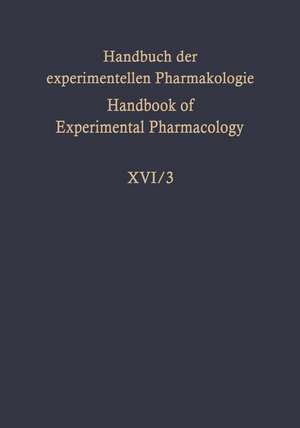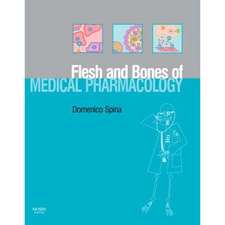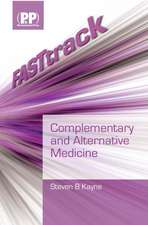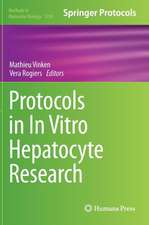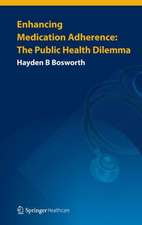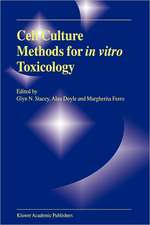Experimental Production of Diseases: Heart and Circulation: Handbook of Experimental Pharmacology, cartea 16 / 3
Editat de J. Schmier Contribuţii de E. Betz, R.J. Bing, H.G. Borst, Y.K. Byon, R Carlson, H.-J. Döring, A. Fleckenstein, A. Grollman, S. Heyden, S. Ikeda, M. S. Islam, J. Jank, H.-G. Lasch, K. Laßnitzer, H. Meisner, G. Müller-Berghaus, J.G. Papp, H.D. Schmidt, L. Szekeres, H. Tillmanns, W. T. Ulmer, M. Weil, M.M. Winburyen Limba Engleză Paperback – 29 feb 2012
Din seria Handbook of Experimental Pharmacology
- 5%
 Preț: 3517.78 lei
Preț: 3517.78 lei - 5%
 Preț: 1425.97 lei
Preț: 1425.97 lei - 5%
 Preț: 1435.28 lei
Preț: 1435.28 lei - 5%
 Preț: 1430.52 lei
Preț: 1430.52 lei - 5%
 Preț: 1930.69 lei
Preț: 1930.69 lei - 5%
 Preț: 1922.47 lei
Preț: 1922.47 lei - 5%
 Preț: 1937.46 lei
Preț: 1937.46 lei - 5%
 Preț: 2117.58 lei
Preț: 2117.58 lei - 5%
 Preț: 2119.96 lei
Preț: 2119.96 lei - 5%
 Preț: 2117.38 lei
Preț: 2117.38 lei - 5%
 Preț: 1088.15 lei
Preț: 1088.15 lei - 5%
 Preț: 1098.27 lei
Preț: 1098.27 lei - 5%
 Preț: 1420.29 lei
Preț: 1420.29 lei - 5%
 Preț: 1104.84 lei
Preț: 1104.84 lei - 5%
 Preț: 1104.84 lei
Preț: 1104.84 lei - 5%
 Preț: 1108.14 lei
Preț: 1108.14 lei - 5%
 Preț: 1106.69 lei
Preț: 1106.69 lei - 5%
 Preț: 1105.77 lei
Preț: 1105.77 lei - 5%
 Preț: 1174.35 lei
Preț: 1174.35 lei - 5%
 Preț: 408.48 lei
Preț: 408.48 lei - 5%
 Preț: 409.63 lei
Preț: 409.63 lei - 5%
 Preț: 539.89 lei
Preț: 539.89 lei - 5%
 Preț: 720.47 lei
Preț: 720.47 lei - 5%
 Preț: 733.09 lei
Preț: 733.09 lei - 5%
 Preț: 731.27 lei
Preț: 731.27 lei - 5%
 Preț: 746.43 lei
Preț: 746.43 lei - 5%
 Preț: 747.72 lei
Preț: 747.72 lei - 5%
 Preț: 725.24 lei
Preț: 725.24 lei - 5%
 Preț: 742.80 lei
Preț: 742.80 lei - 5%
 Preț: 393.23 lei
Preț: 393.23 lei - 5%
 Preț: 735.66 lei
Preț: 735.66 lei - 5%
 Preț: 728.33 lei
Preț: 728.33 lei - 5%
 Preț: 389.52 lei
Preț: 389.52 lei - 5%
 Preț: 730.71 lei
Preț: 730.71 lei - 5%
 Preț: 740.58 lei
Preț: 740.58 lei - 5%
 Preț: 730.19 lei
Preț: 730.19 lei - 5%
 Preț: 723.42 lei
Preț: 723.42 lei - 5%
 Preț: 731.27 lei
Preț: 731.27 lei - 5%
 Preț: 726.68 lei
Preț: 726.68 lei - 5%
 Preț: 3516.49 lei
Preț: 3516.49 lei - 5%
 Preț: 729.26 lei
Preț: 729.26 lei - 5%
 Preț: 737.11 lei
Preț: 737.11 lei - 5%
 Preț: 730.92 lei
Preț: 730.92 lei - 5%
 Preț: 738.78 lei
Preț: 738.78 lei - 5%
 Preț: 909.94 lei
Preț: 909.94 lei - 5%
 Preț: 720.10 lei
Preț: 720.10 lei - 5%
 Preț: 734.74 lei
Preț: 734.74 lei - 5%
 Preț: 727.80 lei
Preț: 727.80 lei - 5%
 Preț: 3513.38 lei
Preț: 3513.38 lei
Preț: 737.85 lei
Preț vechi: 776.67 lei
-5% Nou
Puncte Express: 1107
Preț estimativ în valută:
141.22€ • 146.88$ • 118.35£
141.22€ • 146.88$ • 118.35£
Carte tipărită la comandă
Livrare economică 14-28 martie
Preluare comenzi: 021 569.72.76
Specificații
ISBN-13: 9783642454691
ISBN-10: 3642454690
Pagini: 616
Ilustrații: XII, 602 p.
Dimensiuni: 170 x 244 x 32 mm
Greutate: 0.97 kg
Ediția:Softcover reprint of the original 1st ed. 1975
Editura: Springer Berlin, Heidelberg
Colecția Springer
Seria Handbook of Experimental Pharmacology
Locul publicării:Berlin, Heidelberg, Germany
ISBN-10: 3642454690
Pagini: 616
Ilustrații: XII, 602 p.
Dimensiuni: 170 x 244 x 32 mm
Greutate: 0.97 kg
Ediția:Softcover reprint of the original 1st ed. 1975
Editura: Springer Berlin, Heidelberg
Colecția Springer
Seria Handbook of Experimental Pharmacology
Locul publicării:Berlin, Heidelberg, Germany
Public țintă
ResearchCuprins
Experimental Coronary Disease — Models and Methods of Drug Evaluation.- A. Introduction.- I. Definitions.- II. Common Role of Subendocardial Ischemia.- III. Objective of the Presentation.- B. Pathophysiology of Myocardial Ischemia.- I. Regulation of Tissue Oxygen Tension (pO2).- II. Autoregulation.- III. Effect of Antianginal Drugs.- C. Subendocardium and Effect of Drugs.- I. Anatomy of Circulation through Left Ventricular Wall.- II. Basal State of Left Ventricular Subepicardium and Subendocardium.- D. Regional Resistance — Large and Small Coronary Arteries.- I. Quantitative Angiography.- II. Large and Small Arteries in vivo.- III. Large and Small Arteries in vitro.- E. Regional Tissue Oxygen Tension.- I. Principle and Determinants of Oxygen Tension.- II. Approaches.- III. Polarographic Method.- IV. Mass Spectrographic Method.- V. Conclusions — Regional Oxygen Tension.- F. Regional Blood Flow and Perfusion.- I. Epicardium and Endocardium.- II. Microsphere Method.- III. Hydrogen Clearance with Electrodes.- IV. Mass Spectrometer.- V. Conclusions — Regional Flow.- G. Other Methods for Measurement of Coronary Blood Flow.- I. Thermodilution.- II. Heat Dissipation and Heat Production.- H. Blood Flow and Metabolism of Ischemic Region.- I. Retrograde Blood Flow (Back Flow).- II. Collateral Flow and Metabolism of Ischemic Region.- III. Collateral Flow in Unanesthetized Dogs.- I. Atherosclerosis Model.- Atrial Pacing.- J. Diffuse Coronary Occlusion — Small Vessels.- I. Ischemic Heart Failure and Cardiogenic Shock by Starch Suspensions, Lycopodium Spores or Small Microspheres.- II. Large Spheres — Intra-Aortic.- K. Acute Ligation.- I. Two-Stage Ligation in the Anesthetized Dog.- II. Two-Stage Ligation in the Anesthetized Pig.- III. Monkey, Unanesthetized.- L. Gradualor Controlled Occlusion.- I. Ameroids.- II. Dicetyl Phosphate.- III. Inflatable Balloon.- IV. Hydraulic Occluders.- V. Intracoronary Balloon.- M. Gradual or Acute Thrombosis.- I. Spiral Coils.- II. Electric Induction of Thrombosis.- III. Magnet and Iron Particles.- N. Other Means of Occlusion.- I. Mercury Injection into Coronary.- II. Steel Balls into Coronary.- III. Lead Foil into Coronary.- IV. Steel Cylinder in Coronary.- V. Catheter Tip in Coronary.- VI. Wedging Catheter in Coronary.- O. Surface Electrograms after Occlusion.- I. Electrograms in Open-Chest Dogs.- II. Closed-Chest Conscious Dogs.- P. Contractility of Ischemic Zone.- Q. Partial Occlusion and Pacing in Dog.- R. Summary and Conclusions.- References.- Experimental Induction of Hypertension.- A. Introduction.- B. Experimental Induction of Essential Hypertension.- I. Spontaneous Genetically Determined Hypertension.- II. Teratogenic Induction of Hypertension.- C. Surgical Induction of Chronic Sustained Diastolic Hypertension.- I. The Goldblatt Procedure.- II. Other Procedures for Constricting the Renal Artery.- III. Application of a “Figure-of-Eight” Ligature.- IV. Infarction of the Kidney.- V. Adrenal Regeneration Hypertension.- VI. Miscellaneous Surgical Procedures.- D. Non-Surgical Procedures for Inducing Experimental Chronic Diastolic Hypertension.- I. Salt-Induced Hypertension.- II. DOCA-Induced Hypertension.- III. Hypertension Induced by Dietary Deficiencies.- E. Induction of Special Forms of Hypertension.- I. Systolic Hypertension.- II. Hypertension Secondary to Nephritis and Nephrosclerosis.- III. Surgically Remediable Hypertension.- IV. Renoprival Hypertension.- V. Neurogenic Hypertension.- VI. Malignant Hypertension.- F. Other Procedures for Inducing Experimental Hypertension.- I. Induction ofHypertension by Steroids and Other Hormones.- II. Induction of Hypertension by Other Drugs and Poisons.- III. Induction of Hypertension by Activation of the Immune Mechanism.- G. Conclusion.- References.- Experimental Production of Atherosclerosis: Nutritional Influences.- A. Introduction.- B. The Peanut Oil Problem.- C. Dietary-Induced Cerebral Atherosclerosis.- D. Recent Atherosclerosis-Regression Studies (Aorta and Coronary Artery Only).- E. Lessons from Animal Experiments in Diabetes and Atherosclerosis.- F. “Polyunsaturated Fatty Acid Diet and Cancer” — From the Experimental and Epidemiological Viewpoint.- G. The Soft and Hard Water Hypothesis in Atherogenesis — From the Combined Experimental-Epidemiological Viewpoint.- H. The Issue of Coffee-Caffeine Administration and Atherogenesis of the Aorta and the Coronary Arteries.- I. Pointers from Animal Experiments on Vitamin D Toxicity.- J. Disturbance of Lipid Metabolism in Animals with Brominated Vegetable Oils.- References.- Production of Myocardial Infarcts in Animal Experiments.- A. Historical Background.- B. Methods for Production of Complete or Partial Obstruction of Coronary Arteries.- I. Ligation of Coronary Arteries.- II. Methods of Producing Complete or Partial Occlusion by Means of Clips, Cuffs, Balloons, Screw Forceps, Snares, and Intracranial Arterial Clamps.- III. Occlusion by Means of Embolization and Thrombosis.- IV. Progressive Obstruction Resulting from Application of Ameroid Clamps.- V. Experimental Production of Atherosclerosis through Diet.- References.- Experimental Cardiac Arrhythmias.- A. Introduction.- B. Production of Cardiac Arrhythmias by Electrical Stimulation of the Heart.- I. Single Electrical Shock.- II. Serial Electrical Shocks of Progressively Increasing Intensity.- III.Electrical Stimulation of Continuously Increasing Frequency Rate.- IV. Prolonged Application of Galvanic Current.- C. Cardiac Arrhythmias Evoked by Local Blocks and Spontaneously Firing Ectopic Foci Produced by Local Myocardial Ischemia and Thermal or Mechanical Injury of the Myocardium.- I. Local Myocardial Ischemia.- II. Local Heating or Cooling of the Myocardium.- III. Mechanical Injury of the Myocardium.- D. Induction of Cardiac Arrhythmias by Intravenous Administration or Topical Application of Drugs or Other Chemical Substances.- I. Intravenous Administration of Arrhythmogenic Agents.- 1. Administration of One Arrhythmogenic Agent.- 2. Combined Administration of Several Arrhythmogenic Agents.- II. Topical Application of Arrhythmogenic Agents to the Heart.- E. Production of Cardiac Arrhythmias by Direct Stimulation of the Central Nervous System.- I. Electrical Stimulation of the Central Nervous System.- II. Injection of Drugs or Other Chemical Substances into the Cerebral Ventricles.- III. Increased Intracranial Pressure or Cerebral Compression.- References.- Experimental Production of Cerebral Vascular Disorders.- A. Introduction.- B. Acute Experimental Occlusion.- C. Dysregulation of the Intracerebral Blood Distribution.- D. Effect of Decreased CBF on Cerebral Tissue Energetics.- E. Blood Pressure and Disturbance of the Cerebral Vascular Autoregulation.- F. Changes in Cerebral Activity and Cerebral Blood Flow.- G. Nervous Influences on Cerebral Vessels.- Stimulation and Blockade of the Cervical Autonomic Nerves.- H. Experimental Investigation of the Smooth Muscles of Brain Vessels.- I. Disturbances of CBF by Variation of Blood Gases.- I. Increase in CO2 and CBF.- II. Hypoxia and CBF.- III. Hyperventilation and CBF.- J. Variations of Intracranial Volume and Cerebral Blood Flow.- K. Conclusion.- References.- Experimental Production of Pulmonary Hypertension.- A. Introduction.- B. Pathophysiological Background of the Pulmonary Circulation.- C. Vascular Changes in Pulmonary Hypertension.- D. Methods for the Production of Experimental Pulmonary Hypertension.- I. The Production of Vasoconstriction in the Pulmonary Vascular Bed.- II. Effects of Embolization on the Pulmonary Vascular Bed.- III. Production of Functional Mitral Stenosis.- IV. Production of Hyperkinetic Pulmonary Hypertension.- V. Production of Pulmonary Hypertension Due to Environmental Influence.- VI. Pulmonary Hypertension in Transplantation.- E. Conclusions.- References.- Experimentally Induced Changes in Pulmonary Circulation.- A. Introduction.- B. Morphology and Physiology of the Pulmonary Capillary System.- I. Innervation.- II. Pressure-Flow Relationship.- III. Veno-Arterial Shunt.- IV. Pulmonary Blood Volume.- V. Pulmonary Blood Flow.- VI. Distribution of Perfused Blood.- C. Effect of Physical Agents.- I. High Altitude.- II. Physical Exercise.- III. Gravitational Force.- IV. Pressure Breathing.- V. Hypovolemic Shock.- VI. Pulmonary Emboli.- D. Effects of Chemical Agents.- I. Hypoxia.- II. Hyperoxia.- III. Hypercapnia.- IV. Combination of Hypoxia and Hypercapnia.- V. Anesthetics.- E. Effects of Pharmacological Agents.- I. Acetylcholine (ACH).- II. Histamine.- III. 5-Hydroxytryptamine (5-HT).- IV. Bradykinin.- V. Sympathomimetics.- References.- Genetic Induction of a Cardiomyopathy.- A. Introduction.- I. General Aspects of Myocardial Cell Damage with Special Reference to the Term Cardiomyopathy.- II. Development of Cell Death: Theoretical Analysis.- III. The Purpose Inducing Experimental Myocardial Lesions.- IV. The Significance of Genetically Induced Myocardial Degeneration.- B. Cardiomyopathy of the Syrian Hamster.- I. Genetic Background.- II. Clinical Course and Gross Pathology.- III. Hemodynamic Function and Electrocardiogram.- IV. Serum Enzymes and Electrolytes.- V. Histopathology.- VI. Electron Microscopy.- VII. Biochemistry.- C. Summary and Conclusions.- References.- Basic Actions of Ions and Drugs on Myocardial High-Energy Phosphate Metabolism and Contractility.- A. Introduction.- B. Experimental Procedures.- C. Contractile Failure as a Result of Cardiac High-Energy Phosphate Exhaustion.- I. Myocardial High-Energy Phosphate Breakdown in Anoxia or Ischemia.- II. Time Correlation between Creatine Phosphate Loss and Ventricular Dilation.- III. Degradation of ATP and Other Nucleotides — a Limiting Factor in the Reanimation of Anoxic or Ischemic Hearts.- D. Contractile Cardiac Failure Produced by Deficient Utilization of High-Energy Phosphates.- I. Selective Loss of Myocardial Contractility upon Ca Withdrawal.- II. Basic Mechanisms of Cardiodepression by Interference with Transmembrane Ca Supply.- III. Excitation-Contraction Uncoupling of Heart Muscle by Ca-Antagonistic Bivalent Ni, Co, and Mn Cations.- IV. Restriction of Myocardial Contractility by Organic Compounds with Ca-Antagonistic Side Effects.- V. Discovery of a New Group of Specific Ca-Antagonistic Inhibitors of Excitation-Contraction Coupling.- VI. Neutralization of Ca-Antagonistic Compounds by ?-Adrenergic Catecholamines and Cardiac Glycosides.- VII. Influence of Inhibitors and Promoters of Ca Action on Myocardial High-Energy Phosphate Consumption.- VIII. Drug-Induced Changes in Cardiac Oxygen Requirement.- E. Myocardial High-Energy Phosphate Depletion and Structural Decay.- I. The Fundamental Role of High-Energy Phosphates in Cardica Resting Metabolism.- II.Myocardial Fiber Damage Caused by Exhaustive High-Energy Phosphate Consumption due to Ca Overload.- III. Prevention by Ca-Antagonistic Drugs of Cardiac ATP-Wasting and Necrotization.- References.- Experimental Models of Hemorrhagic Shock.- I. Introduction.- II. Definition of Problem.- A. Techniques for the Production of Hemorrhagic Shock.- I. Pressure-Resistance Model.- II. Volume Model.- B. Pathophysiology of Hemorrhagic Shock.- C. Technical Considerations.- I. Anesthesia.- II. Sterile Technique.- III. Blood Trauma and Microembolization.- IV. Species.- D. Summary and Conclusions.- References.- Some Experimental Shock Models: Traumatic Shock, Catecholamine Shock, Burn Shock and Other Shock Forms.- A. Tourniquet Shock.- B. Shock Induced by Occlusion of the Superior Mesenteric Artery (SMA Shock).- C. Drum Shock.- D. Shock Induced by Direct Destruction of Tissue.- E. Catecholamine Shock.- F. Burn Shock.- G. Shock Induced by Acute Anemia.- H. Shock Induced by Respiratory Oxygen Deficiency.- I. Conclusion.- References.- Microcirculatory Disturbances Induced by Generalized Intravascular Coagulation.- A. Introduction.- B. Historical Notes.- C. Terms and Definitions.- I. Intravascular Coagulation.- II. Generalized or Disseminated Intravascular Coagulation.- III. Consumption Coagulopathy.- IV. Dynamics of Generalized Intravascular Coagulation.- V. Generalized Shwartzman Reaction.- D. Generalized Intravascular Coagulation.- I. Methods of Induction.- 1. Endotoxin.- 2. Antigen-Antibody Reaction.- 3. Thromboplastin and Thrombin.- 4. Snake Venoms.- 5. Viruses.- 6. Nonbiological Substances.- 7. Impaired Perfusion of the Circulatory Periphery—Shock.- 8. Production of a Generalized Shwartzman Reaction by Means of Substances with Defined Mechanisms of Action.- II. Results.- 1.Hematologic Investigations.- 2. Coagulation Studies.- 3. Measurements of Circulatory Parameters.- 4. Pathologicoanatomic Findings.- 5. Impairment of Organ Function.- E. Prevention of Generalized Intravascular Coagulation and of the Generalized Shwartzman Reaction.- I. Interference with the Activation of Intravascular Coagulation.- 1. Antithrombins.- 2. Vitamin K Antagonists.- 3. Hypofibrinogenemia.- 4. Inhibition of Activation of the Hageman Factor.- 5. Cytostatics.- 6. Inhibitors of Platelet Aggregation.- 7. Antibiotics.- II. Interference with the Additional Mechanisms of Microclot Formation.- 1. Alpha-Adrenergic Blocking Agents.- 2. Glucocorticoids.- 3. Fibrinolysis Activators.- F. Pathophysiology.- I. Connexions with Pathophysiology in Man.- 1. Bacterial Endotoxin.- 2. Particulate or Colloidal Substances.- 3. Antigen-Antibody Complexes.- 4. Hypocirculation.- 5. Tissue Thromboplastin.- 6. Proteolytic Enzymes.- II. Coagulation System.- 1. Contact Factors of Blood Coagulation (Plasma Factors XII and XI).- 2. Erythrocytes.- 3. Platelets.- 4. Leukocytes.- 5. Vessel Wall.- III. Fibrinolytic System.- 1. Activation of the Fibrinolytic System.- 2 Inhibition of the Fibrinolytic System.- IV. Complement.- 1. Complement and Endotoxin.- 2. Complement and Generalized Intravascular Coagulation.- V. Reticulo-Endothelial System.- VI. Localizing Factors.- 1. Polymerization and Precipitation of Soluble Fibrin.- 2. Catecholamines.- 3. Corticoids.- 4. Adrenocorticotropic Hormone.- VII. Pregnancy.- VIII. Theory of Pluricausality.- 1. Activation of Intravascular Coagulation.- 2. Localization of Soluble Fibrin.- 3. Inhibition of the Fibrinolytic System.- References.- Author Index.
